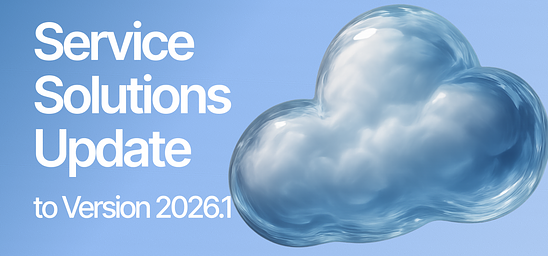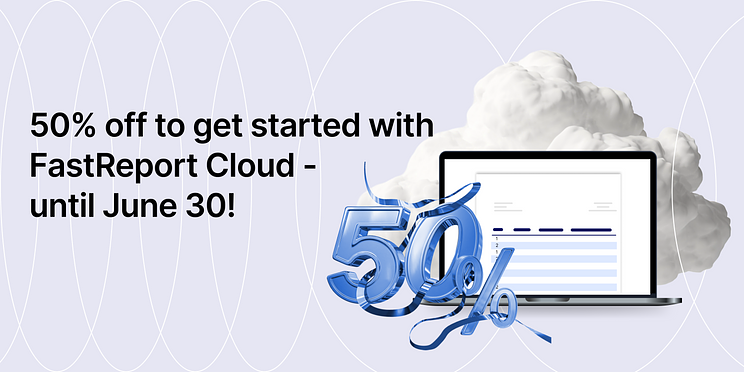News
December 01, 2025
Service Solutions Update to Version 2026.1
In the 2026.1 release of our service solutions lineup, we focused on improving usability, security, and expanding capabilities.
September 25, 2025
Fast Reports at Entwickler Summit
On September 18, Fast Reports took part as an exhibitor at the Entwickler SUMMIT, hosted in the historic Colosseum cinema in Berlin to celebrate the 30th anniversary of Entwickler Magazin.
The event, organized by Software & Support Media, brought together around 2,000 software professionals and became a vibrant meeting point for knowledge sharing, networking, and inspiration. Among the highlights was the presence of Neal Stephenson, world-famous science-fiction author and tech visionary.
For Fast Reports, it was a fantastic opportunity to connect with the developer community, exchange ideas, and showcase our products to an engaged and curious audience. Participants were also able to participate in a raffle. Congrats to the winners! Looking forward to the next event.
September 17, 2025
FastReport VCL now officially supports RAD Studio 13 Florence
Our team has completed work to ensure full compatibility of FastReport VCL (and all its editions) with RAD Studio 13. We thoroughly tested the changes while maintaining backward compatibility with older Delphi versions.
Support for RAD Studio 13, Delphi 13, and C++Builder 13 provides developers with access to new IDE features, improved performance and application stability, as well as reduced debugging time.
Update 2025.2.8 with built-in support for RAD Studio 13 is already available in your customer panel.
August 11, 2025
Celebrate With Us – Enjoy a Discount!
To mark our company’s anniversary, we’re offering a 20% discount on all editions of FastReport VCL, FastReport .NET, and FastReport Desktop!
FastReport VCL – reporting solution for Delphi/C++Builder
FastReport .NET – reporting solution for the .NET platform
FastReport Desktop – a ready-to-use report generator that requires no programming
This offer is valid until August 31, 2025 (inclusive) and applies to new purchases only (not license renewals).
If you’ve been planning to purchase or upgrade our products — now is a great time to do it and save.
Don’t miss the chance to celebrate with us — treat yourself to a great deal!
July 08, 2025
Fast Reports Inc. visited the DWX Mannheim 2025 exhibition
DWX is the event for AI, Cloud, Web and .NET. An estimated number of 2500 software developers, AI pioneers and tech decision-makers was expected in the beautiful Congress Centre Rosengarten in Mannheim. Fast Reports was represented with a booth of 4m² supported by a 55“ flat screen where the Fast Reports movie was constantly played. Expert talks were held throughout the day in different rooms.
To attract potential customers Fast Reports decided to give away a backpack with a LED screen on each day of the event. The raffles took place towards the end of the day during the coffee break. While the participants collected the tickets for the raffle and their batches were scanned, we started an informative small talk about the company.
Most of the booth visitors were software developers employed in companies from various work areas, including aviation and medicine. The needs of our potential customers are still the fast reports in terms of the documentation generating speed rate to save time, money and nerves. We could also impress by giving the information about the standard documentation support of FastReport products like PDF A and ZUGFeRD. Nevertheless, the advantages of processing big data volumes by the FastReport products awakened much interest in our leads.
Evening gatherings like the very well organised Casino Night or the Partner Meet Up gave possibilities to make further contacts and introduce Fast Reports to the most potential customers.
We are looking forward to participating in the Developer Week next year and would like to motivate the organisers to invite more visitors by Partner Networking over the year.
June 05, 2025
Get 1 Year of FastReport Cloud Subscription for Half Price until June 30!
FastReport Cloud is a cloud service for running, storing, editing, and managing reports and documents.
Experience all the benefits of SaaS with 50% savings:
Create reports in the cloud — no load on your computer, accessible from anywhere in the world
Built-in report designer
Automation and scheduled tasks
Collaborative work with flexible access control
Secure operation with protected login and digital signature
Benefits of FastReport functionality: connect to various data sources, export to popular formats, and deliver reports conveniently
Flexible plans to fit every user’s needs
Pay for 6 months, get 12 months of access!
May 26, 2025
Update of Cloud Services to 2025.2 Version
In version 2025.2 of FastReport Cloud and Corporate Server, the ability to use custom fonts has been added, functionality for Tasks, data sources, and preview service has been improved, the installation wizard has been redesigned, and a new edition of Corporate Server — FastReport Publisher — has been introduced.
Font Service
Users can now upload their own fonts in *.ttf and *.otf formats and use them for template design in the Online Designer, in the preview window, and in exports to various formats. Fonts are stored in the user's workspace. New fonts can be added or existing ones can be configured on the "Workspace Information" page or via the API (method descriptions are available at the link https://fastreport.cloud/api/swagger/ in the Fonts section).
Once a font is added, it can be used within the Online Designer.
In the preview window, it will appear as follows.
When exporting to various formats, it will also work correctly. However, please keep in mind some details. For the font to be displayed in the generated document, you need to have that font installed on the device from which the document is being viewed or embed the font in the document itself. This functionality is supported, for example, in PDF export.
Task Filtering by Task Type Added
Two new parameters have been added to the method for retrieving the list of Tasks /api/tasks/v1/Tasks:
taskType
useProjection
The taskType parameter allows the user to specify the type of Tasks to be returned. The useProjection (true/false) parameter indicates whether all information about the task will be returned or only the minimum necessary information.
These parameters will help when you need to find all tasks of the specified types, for example, email tasks and FTP tasks.
Ability to Search for Files Saved as a Result of Task Execution Added
The models of export and prepared reports have been updated to include the fields taskId and taskMessageId. After the execution of transformers, the generated report is saved in the Reports or Exports folder, depending on the type of Task being performed. Additionally, the taskId field of this document includes the identifier of the transformer Task (for example, the task of exporting from a template) that created the file.
To find an export or report by taskId use the following methods:
/api/rp/v1/Exports/File/Task/{taskId}/api/rp/v1/Reports/File/Task/{taskId}
The taskMessageId field contains a unique identifier that is generated with each execution of a Task. Below are the methods used to search for documents created after the specified task execution.
/api/rp/v1/Exports/File/TaskMessage/{taskMessageId}/api/rp/v1/Reports/File/TaskMessage/{taskMessageId}
Additionally, running a "Task without saving" (/api/tasks/v1/Tasks/run) returns taskMessageId, which can be used to find the generated documents in Exports or Prepared Reports.
Custom Query Names in Data Sources Now Unique
With the release of 2025.2, when creating custom SQL queries, table names will be unique. Duplicate names entered will be automatically supplemented with characters to ensure uniqueness. This will help avoid issues when working with the Online Designer.
Parameter Input in the Preview Window
If you open the preview window for a template with parameters, you will see a sidebar where you can set the input for these parameters. After changing a parameter, the report will be restructured. The parameters are also saved in the URL. This means that parameters can be saved in a link and shared with a colleague. Alternatively, you can generate these parameters programmatically and display the current report.
New Demo Application in Java
A new demonstration application in Java has been added, which uses the REST API to work with FastReport Cloud or Corporate Server. Try out our application right now on GitHub.
Saving Sort Orders in the User Panel
The feature to save table sort selections on the user panel pages has been implemented. Now, when the page is reopened, the previously selected sort order will be applied, for example, by date or document size.
Additional Changes for FastReport Corporate Server
Page with License Limitation Description in the Admin Panel
An admin panel page has been added where you can view the current limitations of the Corporate Server.
Improved Corporate Server Installation Wizard
The Corporate Server installer has been significantly reworked. The design and application stability have been enhanced.
FastReport Publisher
A new lightweight edition of the Corporate Server — Publisher — has been introduced. It is designed for companies with a small number of users that do not require the reporting server to be run in a cluster. The Publisher is the most accessible solution for deploying a full-fledged reporting system.
Additionally, the Publisher provides seamless functionality expansion whenever needed. You can find more details about the Publisher on the product page or in articles on the website.
Full List of Changes
[Backend]+ Added task ID and task message ID to export and report; + Added Google Fonts caching; + Added report parameters to temporary files; + Added a new system for fonts; + Added task type filter for retrieval method; + Added company name to configuration; * Custom query names for data sources are now unique; * More options for searching tasks added; * Error messages in the report script are now localized; * Demo and missing white-label headers are now different; - Fixed subscription owner's permissions retrieval; - Fixed file (or folder) moving to the same folder where it was located; - Fixed issue with MongoDB connection; - Incorrect Authorization header will now result in a 401 response instead of using an anonymous user;
[Common]+ Added parameter input in static preview; + Added change log to the product page; + Added a link to Online Designer documentation in Corporate Server documentation; * Documentation removed from Corporate Server loading script; * Updated documentation for VM types in tasks; - Fixed bug with disappearing transports on the tasks page;
[Demos]+ Added new Java REST demo;
[Frontend]+ Added sorting saving to local storage; + Added links to the report store; + Added error handling for data sources that do not support parameters; + Added license limitation page to the admin panel; * Tasks page changed, task controller fixed; * You can no longer click "create task" if it is not in your subscription plan; * SQL query step hidden when editing a data source that is incompatible with SQL; - Added padding in the sidebar, added title to task launch buttons, changed access rights display to a column; - Fixed context menu on document pages; - Fixed double request when creating a folder; - Fixed error regarding empty name parameter in notifications; - Fixed loading indicator in static preview; - Fixed issue with a popup window inside another popup when accepting an invitation in the Corporate Server;
[Installer]+ Added Installer localization; * New Corporate Server installer design;
[SDK]+ Added TasksClient in CSharp SDK.
May 19, 2025
Update of FastReport Online Designer 2025.2
Exciting changes in our product! We are pleased to introduce the new version of Online Designer 2025.2, which includes support for VCL reports in the .fr3 format, the addition of parameters when creating SQL queries, the ability to create new reports when working with .NET WebReport, a new bands menu, and much more.
New Features
[Beta] Support for .fr3 Reports
With the 2025.2 release, an experimental feature for working with .fr3 format reports has been introduced. This format is used in reports for FastReport VCL. Now, you can build a designer for WebReport VCL, which allows using Online Designer for projects based on another reporting platform without the need to adapt existing .fr3 reports.
Available:
All types of horizontal bands are supported
A limited set of components is available (Text object, Image, Table)
Fill styles for components are supported
Component borders are supported
Font settings can be edited
Component properties can be edited
Limitations:
Vertical bands are not available
Creating data sources is not available
There may be differences in property structure and logic of operation.
However, report preview and basic editing are already operational. In future versions, we plan to significantly expand this set of features.
To build Online Designer with support for the FastReport VCL reporting core (in .fr3 format), you can follow these instructions:
1. Open the Designer Builder (FastReport Online Designer Builder).
2. Go to the build page.
3. Select “Reporting Core” from the build menu. This menu allows you to specify which core (.NET or VCL) the designer will be built for.
4. Choose the “VCL” option. This will activate the designer’s build with support for .fr3 format reports. Components related to FastReport .NET will not be included in the build.
5. Click the “Build” button. This will start the process of generating the build with the selected configuration.
Wait for the build to complete. This may take some time depending on the options you have chosen. After the build is finished, you will receive a link to download it.
Please note that this version is in beta status, and there may be limitations in functionality.
Style Editor Implemented
The Online Designer now features a style editor that allows for centralized management of the appearance of report components. You can now create your own styles and customize fill colors, fonts, borders, and other formatting parameters just once. Then, you can apply them to multiple elements without the need to adjust each component manually!
Create a style, adjust it to your requirements, and simply select it for the desired report components. This simplifies the formatting process and ensures a consistent visual style.
Ability to Create Parameters When Writing SQL Queries Added
Now, when creating a custom SQL query in the data source, you can use parameters that make the queries more flexible and adaptable to various scenarios.
In the SQL query creation window, there is now an option to add parameters that can then be used directly in the query text by referencing them with the @ symbol.
For example:
SELECT * FROM Orders WHERE Category = @cateroryParam
Parameters specified in the interface will be automatically substituted when executing the query. This allows for the creation of more versatile reports where data can be filtered based on external conditions or values entered by the user.
Ability to Create a New Report Added
The Online Designer now includes the ability to create a new report when working with WebReport .NET. You can now start creating a report from scratch directly from the interface without the need to upload a file in advance.
A new menu item called “File” has also been implemented, providing convenient access to the main actions related to the report. This menu allows you to:
Create a new report (if supported by your server);
Save the current report;
Change the interface language;
View information about the version and build of the designer.
The new menu simplifies navigation and makes working with reports more flexible and intuitive.
Improvements
New Bands Menu Implemented
In version 2025.2, the band panel has been redesigned with an updated interface and improved structure. The new panel was developed with a focus on responsiveness and ease of use on various devices, including tablets and mobile screens.
Ability to Change the Order of Conditions in the “Text Highlighting” Window Added
The “Text Highlighting” window now has the ability to change the order of conditions that govern text formatting. This is especially useful in cases where multiple rules apply to the same element, and their order affects the display outcome.
This mechanism allows for precise control over the visual logic of the report and helps achieve the desired formatting in various scenarios.
Ability to Use Views and Procedures in Data Sources Added
The new version of the designer introduces support for views and stored procedures in the list of available data sources. Previously, when connecting to a database, the designer only displayed tables, and views were not available for selection. Now, views returned from the server are correctly displayed and can be used alongside regular tables.
After creating a data source, you can use stored procedures and views just like tables.
Please note that the support for views and procedures depends on the capabilities of your database and the connection settings.
Ability to Disable Popup Messages Added
The behavior of popup notifications in the Online Designer can now be configured through settings received from the server when the application starts. This allows for centralized control over the display of messages related to events, errors, or user actions.
In the configuration, it is sufficient to specify the notifications parameter and select one of the operating modes:
"default" — displays built-in notifications in the upper right corner of the interface (default setting);
"html5" — uses system HTML5 notifications (if permission is granted in the browser);
false — completely disables all popup notifications.
Example configuration:
{ notifications: "html5" } — activates system notifications.
{ notifications: false } — completely hides all popup messages.
Full List of Changes
+ Support for reports in .fr3 format;+ Implemented the Style editor;+ Added the ability to create parameters when writing SQL Query;+ Added the ability to use views and procedures in data sources;+ Implemented new bands menu;+ Added the ability to resize the expression editor;+ Added the ability to disable popup messages;+ Added the ability to change the order of conditions in the “Text Highlighting” window;- Fixed an error in the advanced matrix when calculating span (colSpan, rowSpan) in cells;- Fixed the display of the “MSChart Editor” window;- Fixed the behavior of the ruler when clicked frequently;- Fixed fields in the properties panel;- Fixed the Container object;- Improved the appearance of the “Watermark” window;- Fixed an issue with saving ConnectionString;- Fixed an issue with incorrect positioning during drag and drop in the expression editing window;- Fixed the display of the “Fill” window;- Fixed an issue with incorrect restoration of position values when using Ctrl+Z;- Fixed an issue with saving format properties.







.png)